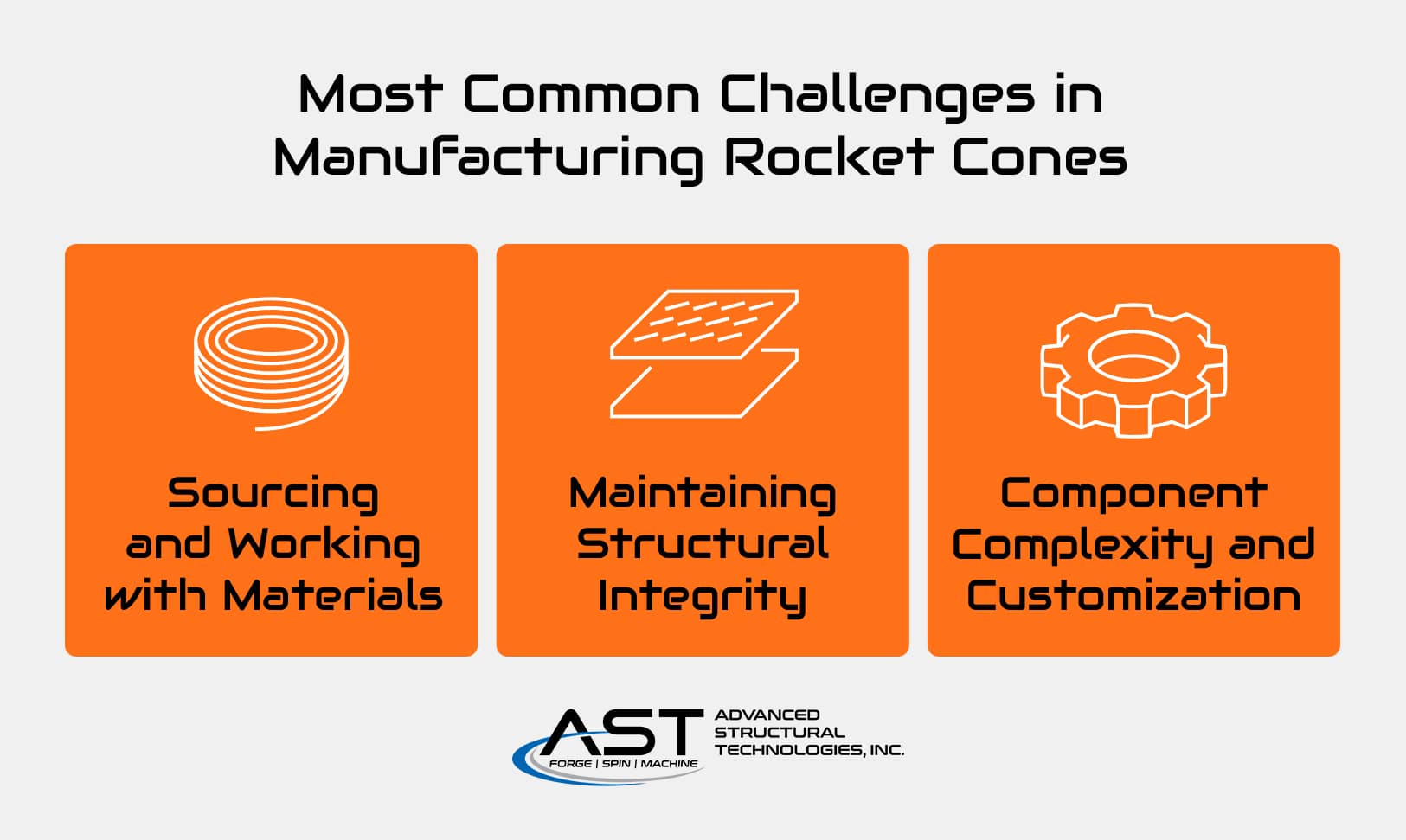Rocket Cone Manufacturing – The AST Advantage

Conical components are critical to rocket manufacturing – essential for aerodynamic performance, structure, and propulsion.
They play a significant role in minimizing aerodynamic drag, protecting internal components, transferring loads, directing fuels, and ensuring the efficient propulsion of the rocket.
Rocket launch teams face challenges in acquiring these components; sourcing high-quality product, ensuring precise manufacturing, and meeting stringent performance requirements.
In this article we are going to review the various types of rocket cones, their functions, and the manufacturing considerations involved.
Then we’ll highlight AST’s unique perspective and innovative processes in producing these critical components, demonstrating how rocket launch teams address their biggest challenges.
Definition of Rocket Cones
Simply put, rocket motor cases are cylindrical or conical-shaped components that house the propellant and combustion chambers within a rocket.
They are designed to withstand extreme pressures and temperatures, providing the structural support necessary for the rocket’s propulsion system.
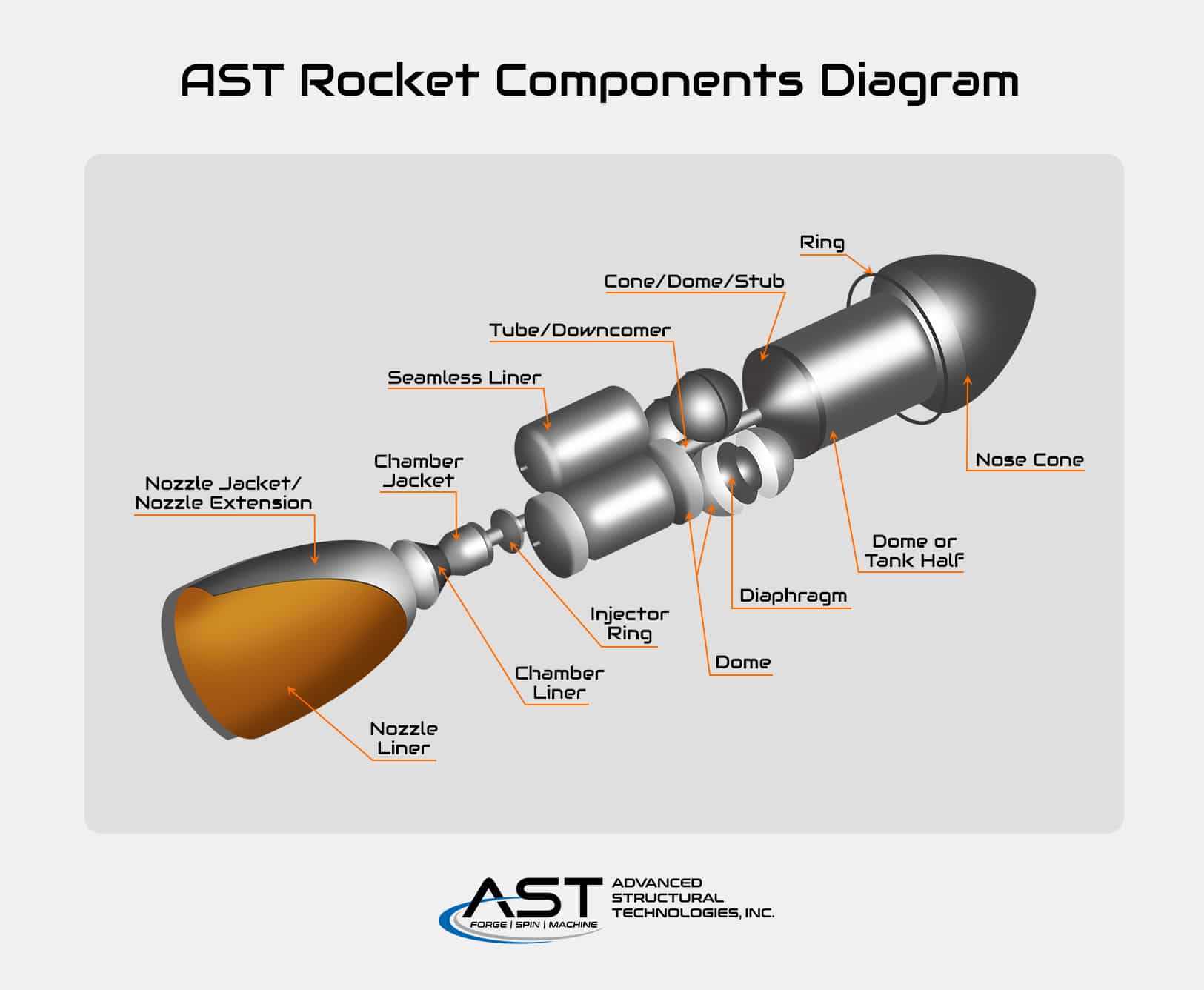 Types of Rocket Cones
Types of Rocket Cones
Nose Cones
- Function: Nose cones are placed at the front of the rocket to reduce aerodynamic drag and protect the payload during ascent.
- Manufacturing Implications: The design and manufacturing of nose cones require precise consideration of aerodynamics, material strength, and weight. Materials such as Inconel and titanium are commonly used due to their lightweight and heat-resistant properties. The manufacturing process must ensure a smooth surface finish and precise shape to minimize drag and withstand atmospheric forces.
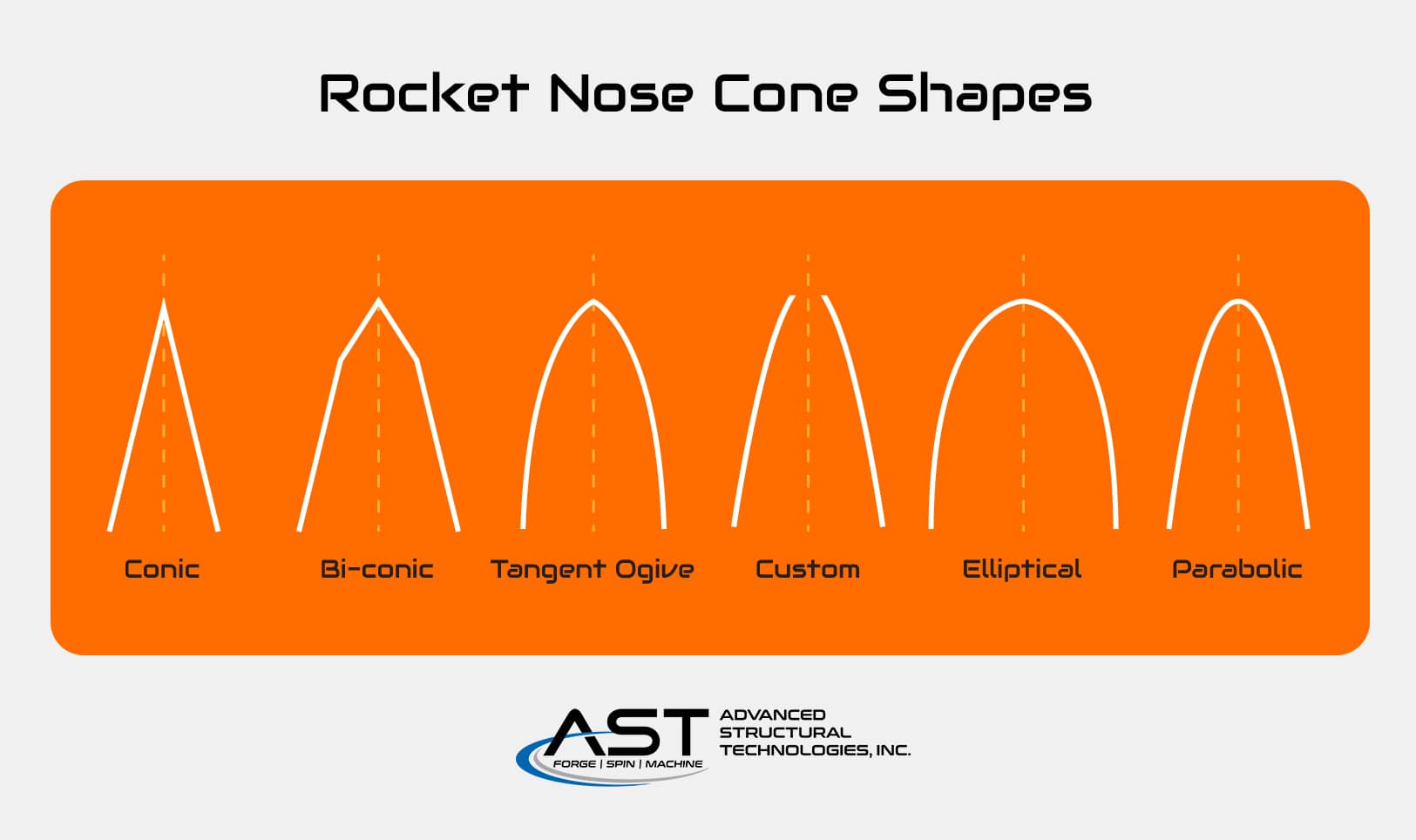
Engine Cones/Nozzles
- Function: These cones direct exhaust gasses for propulsion, playing a critical role in the efficiency and thrust of the rocket engine.
- Manufacturing Implications: Engine cones must withstand extremely high temperatures and stresses. High-performance alloys such as Inconel, Haynes, and niobium are often used. The manufacturing process needs to focus on tolerance and structural integrity. Additionally, the design may include features like flanges for mounting or incorporating additional shapes to reduce downstream costs.
 Structural Cones
Structural Cones
- Function: Structural cones provide support and streamline the rocket’s shape. They can be used in various stages of the rocket, including in the rocket body and the fuel systems.
- Manufacturing Implications: These cones require materials that balance strength and weight, often using aluminum, stainless steel, or high-strength alloys. The manufacturing process must ensure structural stability, precise fit, and compatibility with other rocket components. Handling dynamic forces during flight is critical, and the processes should ensure minimal defects and high precision.
“Whether the wall is a perfectly straight line or whether curved or what the curvature is, is less important than how large it is and it’s wall size the customer needs and what material they’re looking for.”
 Rocket Cone Materials
Rocket Cone Materials
The selection of materials for rocket cones is crucial to ensure their performance under extreme conditions. The materials must provide the necessary strength, heat resistance, and durability while maintaining a lightweight profile.
AST works with a variety of high-performance materials to meet the stringent requirements of aerospace applications.
Common Materials used for Rocket Cones
This table summarizes the materials commonly used for different types of rocket cones, highlighting their key properties and applications.
|
Cone Type |
Common Materials |
Important Properties |
| Nose Cones | Aluminum, Titanium, Inconel, Haynes | Lightweight, heat-resistant, strong |
| Engine Cones/Nozzles | Inconel, Haynes, Niobium, Tungsten, Copper, Titanium | High-temperature resistance, structural integrity |
| Structural Cones | Aluminum, Titanium, Steel, Inconel | High strength, durability, compatibility, light weight |
Best Manufacturing Processes for Rocket Cones
When you’re manufacturing rocket cones it’s crucial to choose the proper metal forming process for the job.
Choosing the right process doesn’t just ensure that the components meet the high standards required for space flight. It also ensures the optimal material efficiency and ideal timeline for the job.
Potential processes include rotary forging, metal spinning, and machining, each providing unique benefits and addressing specific manufacturing challenges.
So if you’re looking to acquire cone shaped components for your launch operation, it helps to work with a partner like Advanced Structural Technologies, who can handle each of these processes in-house.
Let’s dig into each process..
Metal Spinning
- Process: Metal spinning involves clamping a metal preform against a spinning mandrel and using rollers to form the material into the desired cone shape. This technique is highly precise and can produce complex shapes with a smooth surface finish.
- Benefits: Metal spinning offers cost and material savings, flexibility in creating various shapes, and low tooling costs. It is ideal for producing cones quickly and efficiently.
The advantages of metal spinning for rocket cones include; cost, material savings and flexibility in creating any kind of form changes at a low tool cost in fast production runs.
Rotary Forging
- Process: Rotary forging uses a combination of rotational and axial compression movements to shape the metal into the desired cone form. This method ensures uniform thickness and enhances the mechanical properties of the material by precisely controlling the deformation process.
- Benefits: Rotary forging allows for greater material utilization, minimizing or eliminating the need for subsequent machining and welding operations. It produces parts with superior mechanical properties and shorter cycle times.
The benefits of rotary forging cones include shorter cycle times, better mechanical properties from superior working of material, and high material utilization.
Common Challenges in Manufacturing Rocket Cones
Manufacturing rocket cones involves overcoming several significant challenges to meet the stringent requirements of aerospace applications.
These challenges include sourcing high-quality materials, maintaining structural integrity, and customizing designs to meet specific client needs. AST addresses these challenges through advanced manufacturing techniques and a collaborative approach with clients.
1. Sourcing and Working with Materials
High-Quality Material Sourcing: Finding materials that meet the exact specifications for strength, weight, and heat resistance can be difficult. Advanced materials like Inconel, Haynes, and niobium are often required but can be challenging to source in the desired size and quantity.
Material Properties: Working with materials that have unique properties, such as high strength-to-weight ratios and extreme heat resistance, requires specialized knowledge and equipment.
Materials like Inconel, Haynes and niobium material can be notoriously difficult materials to source and work with. This is where a partner like AST comes in handy..
AST’s Solution to Material Sourcing:
- In-house rotary forging: AST has the ability to work from billet as well as from sheet and plate, which allows sourcing from a wider variety of sources.
- Powerful equipment: We’re able to work from thicker materials, which can reduce the amount of forge or roller work that has to be done before spinning.
AST’s in-house rotary forging and powerful spinning machines have helped us select lower price and shorter lead time materials to the benefit of our customers”.
2. Maintaining Structural Integrity
Challenges:
- Grain Structure and Flow: Ensuring consistent grain structure and flow throughout the cone is crucial for maintaining strength and durability. Inconsistent grain flow can lead to weak points and potential failure.
- Stress and Fatigue Resistance: Rocket cones must withstand extreme stresses and fatigue during launch and operation. Ensuring that the material and structure can handle these conditions without degrading is critical.
AST specializes in making components that have controlled grain flow, specific grain properties, particular strength, and elongation.
AST Solution:
- Precision Manufacturing: AST employs precision manufacturing techniques to ensure consistent grain flow and structural integrity.
- Quality Control: Rigorous quality control measures, including non-destructive testing and detailed inspections, ensure that each component meets the highest standards.
3. Component Complexity and Customization
Challenges:
- Design Customization: Clients often require custom designs tailored to specific applications, which can be complex and demanding.
- Integration of Additional Features: Incorporating features such as flanges, attachment points, and varying wall thicknesses adds to the complexity of the manufacturing process.
“We strive to customize or incorporate additional features into the part that increase the value we’re providing to the customer and reduce their downstream costs.”
AST Solution:
- Collaborative Design Process: AST works closely with clients to understand their needs and develop custom solutions that meet their specific requirements.
- Advanced Manufacturing Capabilities: Utilizing advanced manufacturing technologies allows AST to produce highly customized components efficiently and cost-effectively.
The “AST Advantage” for Rocket Cone Manufacturing
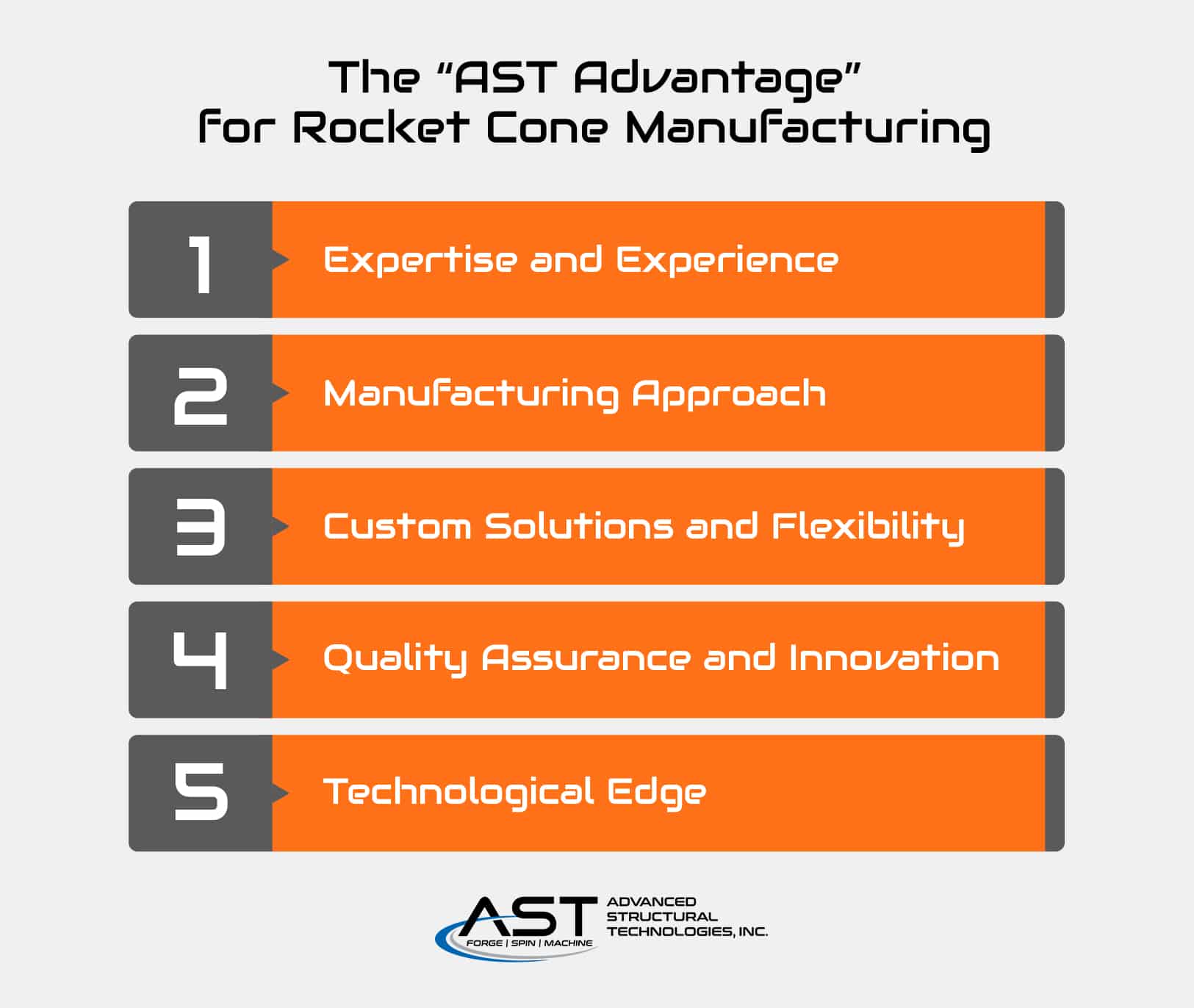 Expertise and Experience
Expertise and Experience
AST (Advanced Structural Technologies) has a long-standing history and deep expertise in manufacturing high-quality rocket components. Over the years, AST has built a reputation for delivering precision-engineered products that meet the stringent requirements of the aerospace industry.
Extensive Industry Experience: With over a decade of experience in aerospace component manufacturing, AST has honed its skills and technologies to produce superior products, consistently.
Projects of Note: AST has been involved in significant projects, such as the development of titanium cone components and Inconel parts for high-performance rocket engines, proving our capability to handle complex materials and challenging specifications.
Manufacturing Approach
AST’s manufacturing approach is centered around a client-centric and collaborative design process. This approach ensures that the end product meets the client’s specific requirements and industry standards.
Collaborative Design Process: AST works closely with clients to understand their needs and provides tailored solutions. This collaboration helps in refining designs and achieving optimal production outcomes.
“We try to dive in and figure out what it is the customer is ultimately trying to deliver.. Whether it’s eliminating a weld or incorporating a flange or doing something else to enhance their delivered part.. Our customers can focus on the end goal and we’re focused on how to make it.”
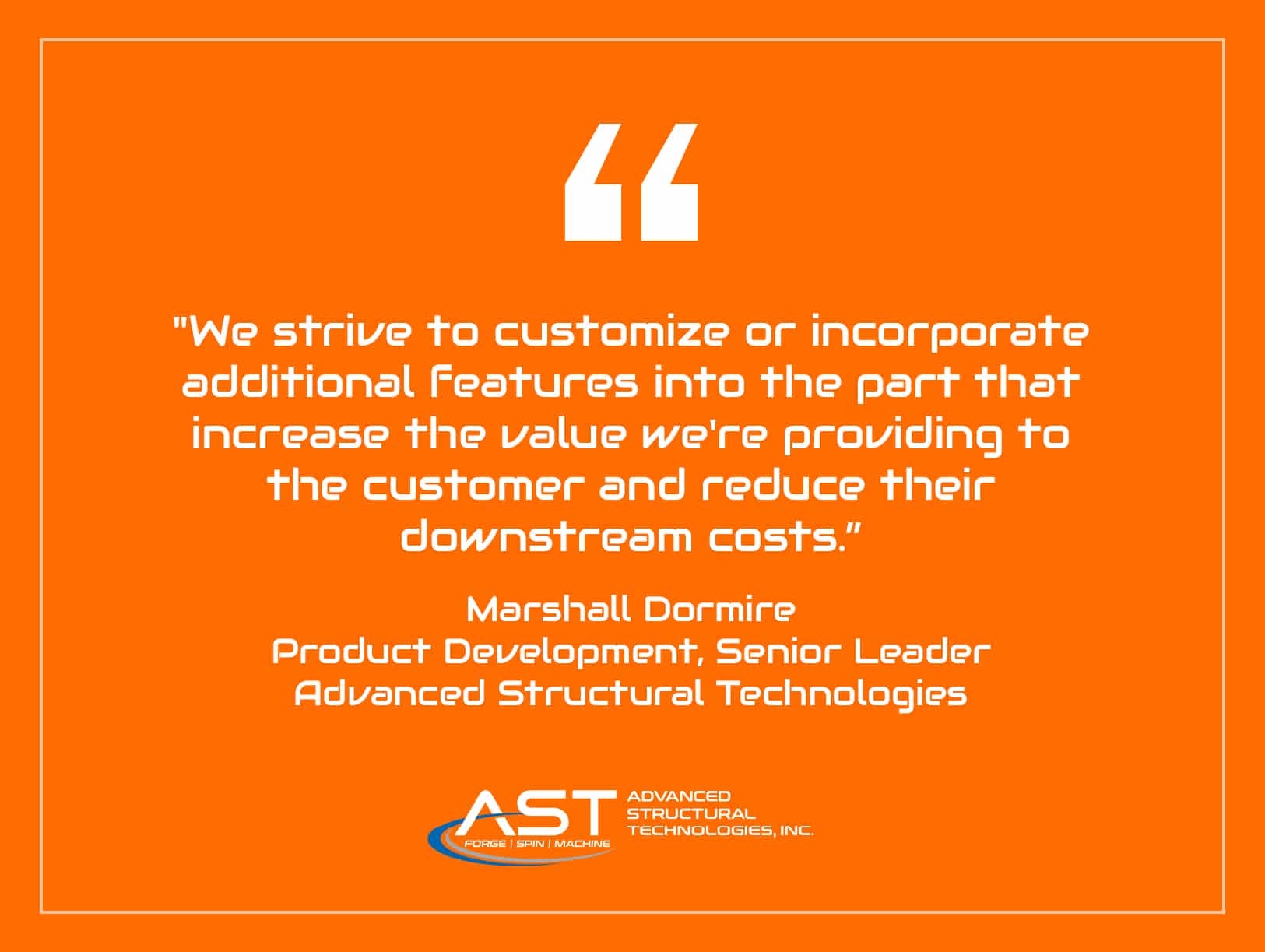 Custom Solutions and Flexibility
Custom Solutions and Flexibility
AST excels in offering customized solutions, addressing specific client needs with flexibility and innovation. This capability is crucial in an industry where bespoke components are often required.
Material Efficiency: AST’s processes are designed to maximize material efficiency, reducing waste and costs.
Component Quality: Emphasis on high-quality manufacturing ensures that components meet the highest standards.
Turnaround Time: AST’s advanced manufacturing techniques enable quick turnaround times, meeting tight project deadlines.
Quality Assurance and Innovation
Quality assurance and continuous innovation are at the core of AST’s manufacturing philosophy. AST implements rigorous quality control measures and constantly seeks to push the boundaries of what is possible in aerospace component manufacturing.
Grain Structure, Strength, and Elongation: AST ensures that the grain structure, strength, and elongation of materials are optimized for performance and durability.
Commitment to Innovation: AST continuously explores new techniques and materials to stay ahead in the industry.
Technological Edge
AST’s investment in advanced technologies, such as the new powerful spinning machine, sets it apart from competitors. This machine enhances AST’s capabilities, allowing for the production of larger and more complex components with greater efficiency and precision.
New Spinning Machine: This machine allows AST to work with larger and heavier metals more efficiently, expanding the size and material range AST can handle.
Our new machine provides us not just a step up in the size of the machine, but also a step up in the power that the machine is going to be able to provide.
This helps us with working with some of the heavier and stronger materials and gives us a chance to make even larger as well as heavier parts and in more complicated and stronger materials.
Technological Advancements: Continued investment in cutting-edge technology improves AST’s manufacturing processes, enhancing both efficiency and quality.
Conclusion
In the space industry, it’s well known that the precision and quality of rocket components are critical in the success of space missions.
Rocket cones are vital for the aerodynamic performance and structural integrity of rockets.
In this article, we’ve reviewed the various types of rocket cones, their functions, and the key manufacturing considerations. As well as highlighting AST’s unique capabilities in producing these components, demonstrating our differentiated approach to addressing the industry’s biggest challenges.
AST is dedicated to supporting rocket launch teams by providing top-tier manufacturing services for rocket cones and other aerospace components. To optimize your supply chain and ensure the highest quality for your rocket components, contact AST to learn more about how we can assist you.
For more information, please visit our website or contact our sales team at [email protected]. Explore how AST can help you achieve your aerospace goals with precision-engineered solutions tailored to your needs.



